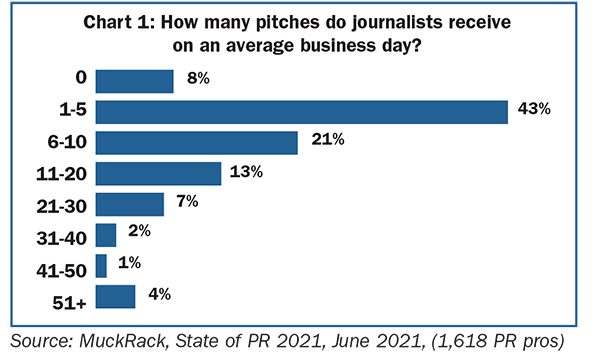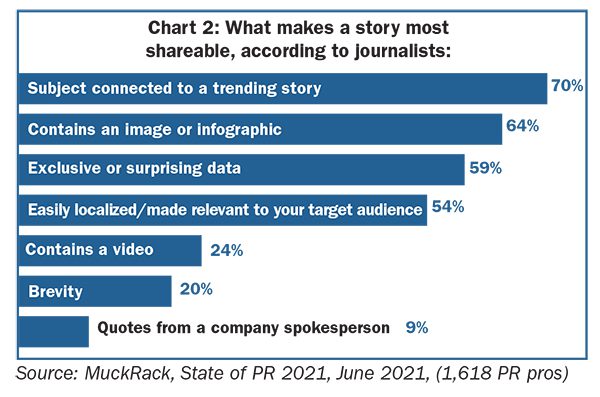
It’s hard enough to get media placement for a launch, initiative or campaign. Indeed, obtaining “coverage in the new news cycle” and “finding relevant angles for pitches” are PR pros’ biggest concerns, according to a Muckrack report.
Let’s add another hurdle: getting coverage in a crowded media landscape (see chart 1) when your organization or product is perceived as dry or unsexy. Despite the image of the PR profession as glamorous, communicators may spend a lot time pitching mundane topics, such as sewer renovation, pest control or oven construction, for example. It’s the rare PR pro who’s pitching ‘hot’ stories constantly.

One of the first hurdles is the pitcher’s perception, says Krystal Covington, founder, Go Lead Consulting of Denver.
“While in your world what you’re [pitching] is unique, in [the journalist’s] world...it might take more depth and more newsworthiness,” for it to get covered, Covington says. “[Journalists] need to connect [your pitch] to something that requires them to act quickly.” (See chart 2).

Newsjacking, Events and Holidays
One way to get a journalist to consider a pitch about a product or organization that is perceived as mundane is via newsjacking. This tactic has its time and place when done well. Remember the Biden campaign fly swatter? Or does Four Seasons Total Landscaping ring a bell? But it’s important to newsjack only when there’s a meaningful connection to a pitch.
“Commenting on a trend or trending news [only] for the sake of it is ill-advised, unless you have something meaningful to say about it—and are confident that being associated with that trend or news suits your [brand],” says April Margulies, president and founder of virtual agency Trust Relations.
Another newsjacking-like option is to peg a pitch to holidays, anniversaries and awareness days, weeks and months. Moreover, this allows media relations pros to plan ahead. For example, if you’re a PPE manufacturer, you could peg a pitch to National Safety Month. Here’s how:
- draft an article that includes insight into statistics and data, demonstrating the need for certain techniques and/or equipment;
- hold a free event (virtual or in-person), giving demonstrations of equipment for certain job sites and tasks;
- create a whitepaper that outlines new statistics or insights that may provide newsworthy data for media, in addition to valuable information for customers; and/or
- offer a free product giveaway in honor of National Safety Month via a social media and/or online campaign.
Thought Leadership Wins
While events, planned or not, provide pitch opportunities, it’s important to keep employees in mind too–and not just senior executives.
“We always try to stay aware of current trends in the industry,” says Laura Meyers, senior manager of corporate communications at Bonadio Group, a top 50 accounting firm.
“Being able to tie thought leadership to an overarching trend often appeals to journalists.”
Meyers admits it can be challenging to secure coverage in national publications. But, she says, leveraging thought leadership has proven helpful, even in instances where it might not seem like an obvious tie to accounting.
While many see accounting as dry, the pandemic provided an opportunity for Bonadio to shift its pitching plans.
Recognizing that many clients and the public needed guidance to understand COVID-related funding and loans, Meyers’s team went from pitching traditional accounting stories to topics whose relevance increased during the pandemic.
Lesson learned: flexibility can help get media for organizations whose mainstay is widely considered unexciting.

Consider The Whole Organization
 Another tactic applies to all sectors, exciting or not: Look at all parts of a company to find pitch ideas.
Another tactic applies to all sectors, exciting or not: Look at all parts of a company to find pitch ideas.
Meyers’ team, for example, looks at stories within the accounting firm’s HR, marketing and IT departments. Such pitches “may have more of a lure to reach publications than stories that come out of accounting, tax and audit departments,” she says.
There are issues, though, including a lack of media training. Bonadio, however, provides internal media training for staff. In addition, the PR team ensures spokespeople are equipped with key messaging points related to the topic of expertise as well as to the firm as a whole.
These points ladder up to Bonadio’s “strategic plan cornerstones” and, Meyers adds, “whenever possible, we try to incorporate messaging that ties into our overall Bonadio Purpose as well.”
In this vein, Meyers has secured coverage in business and HR trade publications about her firm’s evolving HR policies. For instance, a managing partner is quoted in “15 Leaders Share Invaluable Lessons They’ve Learned from Their Employees.” While this article is not direrctly related to accounting, it puts the Bonadio name in front of readers.
“When simply trying to raise awareness to the general public, we have more flexibility in the topics we promote, discuss and weigh in on,” says Meyers. “When trying to increase awareness of a specific service offering or industry serviced, we have to take a bit more of a targeted approach.”
And back to basics, Meyers says leveraging data whenever possible helps make a story pitch pop, either with a timely statistic or a link to a recent report relevant to the topic. 59 percent of journalists say exclusive or surprising data make a story more shareable. (See Chart 2).
Seeking a Fresh Angle
Nick Vivion, founder of Ghost Works Communications, advises using a traditional PR tactic: Approach pitching with a fresh angle on what seems a routine topic.
“In a world where competitors are solving the same problem, there has to be a differentiator” to get your story told, he says.
For technology or manufacturing companies, ideas from innovation units can help make pitches from a seemingly sleepy company more interesting.
An extension of looking at an entire company calls for pitchers to consider personnel beyond senior executives.
“You just never know where a good story comes from,” Vivion says, speaking to PRNEWS from the RV where he lives (proving his point).
Most communicators likely have regular interactions with VPs and top executives. Yet, moving down a level, it’s managers dealing with daily issues who are able to discuss problems that were solved. Story pitches about these solutions can be compelling.
In addition, Vivion suggests pitching stories about why certain products were built.
“Tweaking products to be more media-ready is a bit of a hack that can make even the most vanilla product stand out,” he says.
When meeting with companies, he likes to ask a lot of questions, take many meetings and hold discovery sessions about a product’s development. “It comes down to thinking like a journalist from a story perspective…and not assuming that something is boring up front.”
But it’s not just about getting to the story of why a product was built; sometimes it’s about “reframing product development,” he says. “Usually [companies] forget about PR until after a product” is complete. When given the opportunity, he likes to ask product development teams whether there is something about a given product that plays into a current trend.
